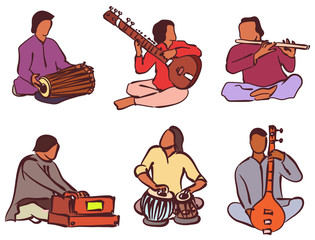Margi Vs Deshi Sangeet
Deshi Vs Margi Sangeet
Vedic music, or sacred music, and Loukik music, or secular music, are two categories that can be used to describe early Indian music. Vedic music, also known as religious music, was wholly religious in nature. Loukik, or secular music, came in two varieties: Gandharv Loukik and Deshi Loukik.
The so-called Margi Sangeet or Margi Music was the Gandharva Loukik tradition, while the so-called Deshi Sangeet was the Deshi Loukik tradition.
The Bhugandharv class of people practiced Margi Sangeet at the temples. Deshi Sangeet was the music played outside of temples in the past. In various aspects, it was different from Margi Sangeet:
The Gandharvas or others under the guidance of the Gandharvas, who were skilled in the arts, practiced Margi Sangeet.
Three types of Gandharvas existed:
- The dramatists belong to the Bharat sect.
- The musicians of the Narad sect.
- The dance director of the Tandu sect.
Deshi Sangeet was associated with life outside of temples or performance venues, whereas Margi Sangeet was music played in temples or during performances.
Margi Sangeet featured defined grammar principles, strict song structures, and strict melodic and rhythmic guidelines. Deshi Sangeet was first exempt from these laws but later became somewhat, but not entirely, subject to the Gandharvic laws. Deshi Sangeet with such Gandharv influences is what gave rise to the Raag in Indian Classical music.
Margi Sangeet was employed for theatre performances as well as certain religious requirements, such as mystic activities. The theatre was an organized type of classical art with tight guidelines for the placement of preset acceptable music. An orchestra by the name of Kutap was used in it.
However, Deshi Sangeet did not typically have the limitations of Margi Sangeet. Margi Sangeet was built on two different sorts of melodic logic:
- Bharat sect practices jati.
- Narad sect practices rag.
These Raags should not be confused with the Deshi tradition's Raags. The Margi tradition's Raags, which are no longer utilised, were sung during religious services or theatrical events. The Deshi Raag traditions still exist today, but they have undergone numerous influences and changes along the way, including significant incorporations from the Raags and Margi tradition's regulations. For instance, the Moorchhana rule, which mandates the usage of specific note progressions, is a regulation pertaining to Raag.
Because it made use of several rhythm structures that were popular at the time, Margi Sangeet earned its name. These structures, which had names like Dakshin Margi, Chitra Margi, Vartik Margi, etc., were tied to the speed of the music.
These restrictions did not apply to Deshi music.


Comments
Post a Comment